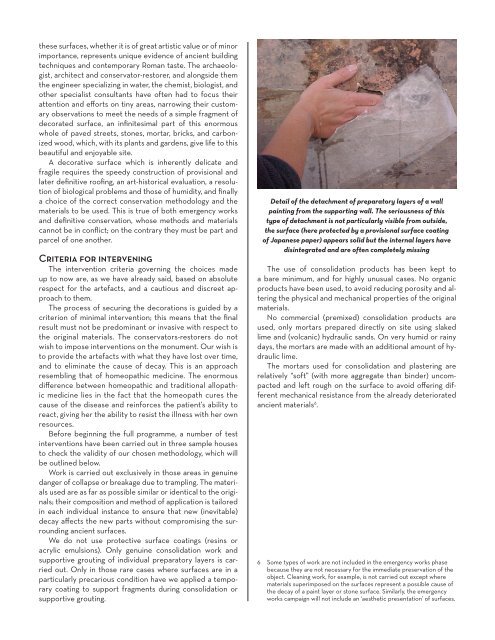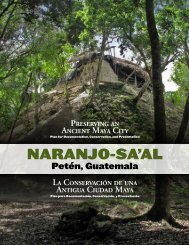Summary of the Proceedings and Papers Presented at - World ...
Summary of the Proceedings and Papers Presented at - World ...
Summary of the Proceedings and Papers Presented at - World ...
You also want an ePaper? Increase the reach of your titles
YUMPU automatically turns print PDFs into web optimized ePapers that Google loves.
<strong>the</strong>se surfaces, whe<strong>the</strong>r it is <strong>of</strong> gre<strong>at</strong> artistic value or <strong>of</strong> minor<br />
importance, represents unique evidence <strong>of</strong> ancient building<br />
techniques <strong>and</strong> contemporary Roman taste. The archaeologist,<br />
architect <strong>and</strong> conserv<strong>at</strong>or-restorer, <strong>and</strong> alongside <strong>the</strong>m<br />
<strong>the</strong> engineer specializing in w<strong>at</strong>er, <strong>the</strong> chemist, biologist, <strong>and</strong><br />
o<strong>the</strong>r specialist consultants have <strong>of</strong>ten had to focus <strong>the</strong>ir<br />
<strong>at</strong>tention <strong>and</strong> efforts on tiny areas, narrowing <strong>the</strong>ir customary<br />
observ<strong>at</strong>ions to meet <strong>the</strong> needs <strong>of</strong> a simple fragment <strong>of</strong><br />
decor<strong>at</strong>ed surface, an infinitesimal part <strong>of</strong> this enormous<br />
whole <strong>of</strong> paved streets, stones, mortar, bricks, <strong>and</strong> carbonized<br />
wood, which, with its plants <strong>and</strong> gardens, give life to this<br />
beautiful <strong>and</strong> enjoyable site.<br />
A decor<strong>at</strong>ive surface which is inherently delic<strong>at</strong>e <strong>and</strong><br />
fragile requires <strong>the</strong> speedy construction <strong>of</strong> provisional <strong>and</strong><br />
l<strong>at</strong>er definitive ro<strong>of</strong>ing, an art-historical evalu<strong>at</strong>ion, a resolution<br />
<strong>of</strong> biological problems <strong>and</strong> those <strong>of</strong> humidity, <strong>and</strong> finally<br />
a choice <strong>of</strong> <strong>the</strong> correct conserv<strong>at</strong>ion methodology <strong>and</strong> <strong>the</strong><br />
m<strong>at</strong>erials to be used. This is true <strong>of</strong> both emergency works<br />
<strong>and</strong> definitive conserv<strong>at</strong>ion, whose methods <strong>and</strong> m<strong>at</strong>erials<br />
cannot be in conflict; on <strong>the</strong> contrary <strong>the</strong>y must be part <strong>and</strong><br />
parcel <strong>of</strong> one ano<strong>the</strong>r.<br />
Criteria for intervening<br />
The intervention criteria governing <strong>the</strong> choices made<br />
up to now are, as we have already said, based on absolute<br />
respect for <strong>the</strong> artefacts, <strong>and</strong> a cautious <strong>and</strong> discreet approach<br />
to <strong>the</strong>m.<br />
The process <strong>of</strong> securing <strong>the</strong> decor<strong>at</strong>ions is guided by a<br />
criterion <strong>of</strong> minimal intervention; this means th<strong>at</strong> <strong>the</strong> final<br />
result must not be predominant or invasive with respect to<br />
<strong>the</strong> original m<strong>at</strong>erials. The conserv<strong>at</strong>ors-restorers do not<br />
wish to impose interventions on <strong>the</strong> monument. Our wish is<br />
to provide <strong>the</strong> artefacts with wh<strong>at</strong> <strong>the</strong>y have lost over time,<br />
<strong>and</strong> to elimin<strong>at</strong>e <strong>the</strong> cause <strong>of</strong> decay. This is an approach<br />
resembling th<strong>at</strong> <strong>of</strong> homeop<strong>at</strong>hic medicine. The enormous<br />
difference between homeop<strong>at</strong>hic <strong>and</strong> traditional allop<strong>at</strong>hic<br />
medicine lies in <strong>the</strong> fact th<strong>at</strong> <strong>the</strong> homeop<strong>at</strong>h cures <strong>the</strong><br />
cause <strong>of</strong> <strong>the</strong> disease <strong>and</strong> reinforces <strong>the</strong> p<strong>at</strong>ient’s ability to<br />
react, giving her <strong>the</strong> ability to resist <strong>the</strong> illness with her own<br />
resources.<br />
Before beginning <strong>the</strong> full programme, a number <strong>of</strong> test<br />
interventions have been carried out in three sample houses<br />
to check <strong>the</strong> validity <strong>of</strong> our chosen methodology, which will<br />
be outlined below.<br />
Work is carried out exclusively in those areas in genuine<br />
danger <strong>of</strong> collapse or breakage due to trampling. The m<strong>at</strong>erials<br />
used are as far as possible similar or identical to <strong>the</strong> originals;<br />
<strong>the</strong>ir composition <strong>and</strong> method <strong>of</strong> applic<strong>at</strong>ion is tailored<br />
in each individual instance to ensure th<strong>at</strong> new (inevitable)<br />
decay affects <strong>the</strong> new parts without compromising <strong>the</strong> surrounding<br />
ancient surfaces.<br />
We do not use protective surface co<strong>at</strong>ings (resins or<br />
acrylic emulsions). Only genuine consolid<strong>at</strong>ion work <strong>and</strong><br />
supportive grouting <strong>of</strong> individual prepar<strong>at</strong>ory layers is carried<br />
out. Only in those rare cases where surfaces are in a<br />
particularly precarious condition have we applied a temporary<br />
co<strong>at</strong>ing to support fragments during consolid<strong>at</strong>ion or<br />
supportive grouting.<br />
Detail <strong>of</strong> <strong>the</strong> detachment <strong>of</strong> prepar<strong>at</strong>ory layers <strong>of</strong> a wall<br />
painting from <strong>the</strong> supporting wall. The seriousness <strong>of</strong> this<br />
type <strong>of</strong> detachment is not particularly visible from outside,<br />
<strong>the</strong> surface (here protected by a provisional surface co<strong>at</strong>ing<br />
<strong>of</strong> Japanese paper) appears solid but <strong>the</strong> internal layers have<br />
disintegr<strong>at</strong>ed <strong>and</strong> are <strong>of</strong>ten completely missing<br />
The use <strong>of</strong> consolid<strong>at</strong>ion products has been kept to<br />
a bare minimum, <strong>and</strong> for highly unusual cases. No organic<br />
products have been used, to avoid reducing porosity <strong>and</strong> altering<br />
<strong>the</strong> physical <strong>and</strong> mechanical properties <strong>of</strong> <strong>the</strong> original<br />
m<strong>at</strong>erials.<br />
No commercial (premixed) consolid<strong>at</strong>ion products are<br />
used, only mortars prepared directly on site using slaked<br />
lime <strong>and</strong> (volcanic) hydraulic s<strong>and</strong>s. On very humid or rainy<br />
days, <strong>the</strong> mortars are made with an additional amount <strong>of</strong> hydraulic<br />
lime.<br />
The mortars used for consolid<strong>at</strong>ion <strong>and</strong> plastering are<br />
rel<strong>at</strong>ively “s<strong>of</strong>t” (with more aggreg<strong>at</strong>e than binder) uncompacted<br />
<strong>and</strong> left rough on <strong>the</strong> surface to avoid <strong>of</strong>fering different<br />
mechanical resistance from <strong>the</strong> already deterior<strong>at</strong>ed<br />
ancient m<strong>at</strong>erials 6 .<br />
6 Some types <strong>of</strong> work are not included in <strong>the</strong> emergency works phase<br />
because <strong>the</strong>y are not necessary for <strong>the</strong> immedi<strong>at</strong>e preserv<strong>at</strong>ion <strong>of</strong> <strong>the</strong><br />
object. Cleaning work, for example, is not carried out except where<br />
m<strong>at</strong>erials superimposed on <strong>the</strong> surfaces represent a possible cause <strong>of</strong><br />
<strong>the</strong> decay <strong>of</strong> a paint layer or stone surface. Similarly, <strong>the</strong> emergency<br />
works campaign will not include an ‘aes<strong>the</strong>tic present<strong>at</strong>ion’ <strong>of</strong> surfaces.
















